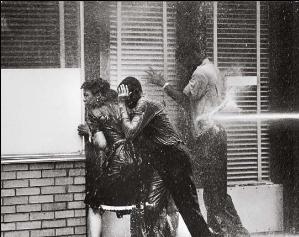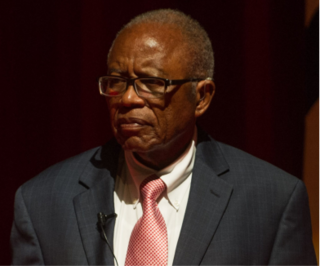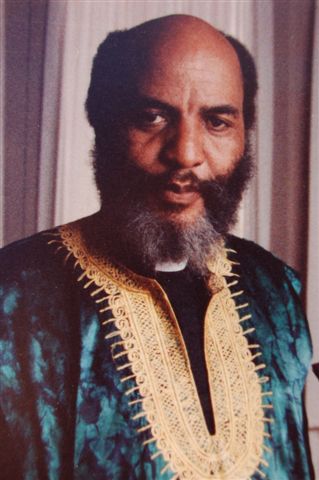Brown v. Board of Education of Topeka, 347 U.S. 483 (1954), was a landmark decision of the U.S. Supreme Court that ruled that U.S. state laws establishing racial segregation in public schools are unconstitutional, even if the segregated schools are otherwise equal in quality. The decision partially overruled the Court's 1896 decision Plessy v. Ferguson, which had held that racial segregation laws did not violate the U.S. Constitution as long as the facilities for each race were equal in quality, a doctrine that had come to be known as "separate but equal". The Court's unanimous decision in Brown, and its related cases, paved the way for integration and was a major victory of the civil rights movement, and a model for many future impact litigation cases.

The Southern Christian Leadership Conference (SCLC) is an African-American civil rights organization based in Atlanta, Georgia. SCLC is closely associated with its first president, Martin Luther King Jr., who had a large role in the American civil rights movement.

Gebhart v. Belton, 33 Del. Ch. 144, 87 A.2d 862, aff'd, 91 A.2d 137, was a case decided by the Delaware Court of Chancery in 1952 and affirmed by the Delaware Supreme Court in the same year. Gebhart was one of the five cases combined into Brown v. Board of Education, the 1954 decision of the United States Supreme Court which found unconstitutional racial segregation in United States public schools.

The NAACP Legal Defense and Educational Fund, Inc. is an American civil rights organization and law firm based in New York City.

Freddie Lee Shuttlesworth was an American minister and civil rights activist who led fights against segregation and other forms of racism, during the civil rights movement. He often worked with Martin Luther King Jr., although they did not always agree on tactics and approaches.
Allen v. Wright, 468 U.S. 737 (1984), was a United States Supreme Court case that determined that citizens do not have standing to sue a federal government agency based on the influence that the agency's determinations might have on third parties.

Frank Minis Johnson Jr. was a United States district judge and United States circuit judge serving 1955 to 1999 on the United States District Court for the Middle District of Alabama, United States Court of Appeals for the Fifth Circuit and United States Court of Appeals for the Eleventh Circuit. He made landmark civil rights rulings that helped end segregation and disenfranchisement of African Americans in the South. In the words of journalist and historian Bill Moyers, Judge Johnson "altered forever the face of the South."
Birmingham City Schools is a public school district that serves the US city of Birmingham, Alabama. It is the fourth-largest school system in Alabama behind Mobile County Public School System, Jefferson County School System, and Montgomery Public Schools. It currently enrolls approximately 25,000 students across 42 schools.

The Birmingham campaign, also known as the Birmingham movement or Birmingham confrontation, was an American movement organized in early 1963 by the Southern Christian Leadership Conference (SCLC) to bring attention to the integration efforts of African Americans in Birmingham, Alabama.

Fred David Gray is an American civil rights attorney, preacher, activist, and state legislator from Alabama. He handled many prominent civil rights cases, such as Browder v. Gayle, and was elected to the Alabama House of Representatives in 1970, along with Thomas Reed, both from Tuskegee. They were the first black state legislators in Alabama in the 20th century. He served as the president of the National Bar Association in 1985, and in 2001 was elected as the first African-American President of the Alabama State Bar.

James Luther Bevel was an American minister, leader of the 1960s Civil Rights Movement in the United States, and convicted child molester. As a member of the Southern Christian Leadership Conference (SCLC), and then as its director of direct action and nonviolent education, Bevel initiated, strategized, and developed SCLC's three major successes of the era: the 1963 Birmingham Children's Crusade, the 1965 Selma voting rights movement, and the 1966 Chicago open housing movement. He suggested that SCLC call for and join a March on Washington in 1963 and strategized the 1965 Selma to Montgomery marches which contributed to Congressional passage of the 1965 Voting Rights Act.
Albert Burton Boutwell was the 19th Lieutenant Governor of Alabama. A Democrat, Boutwell served Governor John Malcolm Patterson of the same political party, from 1959 until 1963. Earlier in his political career he served in the state senate, including as senate president, and later as mayor of Birmingham.
Board of Education of Oklahoma City v. Dowell, 498 U.S. 237 (1991), was a United States Supreme Court case "hasten[ing] the end of federal court desegregation orders."
Green v. County School Board of New Kent County, 391 U.S. 430 (1968), was an important United States Supreme Court case involving school desegregation. Specifically, the Court dealt with the freedom of choice plans created to avoid compliance with the Supreme Court's mandate in Brown II in 1955. The Court held unanimously that New Kent County's freedom of choice plan did not adequately comply with the school board's responsibility to determine a system of admission to public schools on a non-racial basis. The Supreme Court mandated that the school board must formulate new plans and steps towards realistically converting to a desegregated system. Green v. County School Board of New Kent County was a follow-up of Brown v. Board of Education.
Seybourn Harris Lynne was an American jurist. He was United States district judge for the United States District Court for the Northern District of Alabama. He was Chief Judge of the court from 1953 to 1973. At the time of his death, he was the longest-serving judge on the federal bench and the last remaining judge appointed by President Truman. Judge Lynne served from 1946 to 2000, although his final 27 years were in senior status.
Daniel Holcombe Thomas was a United States district judge who served nearly five decades on the United States District Court for the Southern District of Alabama.
The Alabama Christian Movement for Human Rights (ACMHR) was an American civil rights organization in Birmingham, Alabama, which coordinated boycotts and sponsored federal lawsuits aimed at dismantling segregation in Birmingham and Alabama during the civil rights movement. Fred Shuttlesworth, pastor of Bethel Baptist Church, served as president of the group from its founding in 1956 until 1969. The ACMHR's crowning moment came during the pivotal Birmingham campaign which it coordinated along with the Southern Christian Leadership Conference during the spring of 1963.
The Original Ku Klux Klan of the Confederacy was a Klan faction led by Asa Carter in the late 1950s. Despite the group's brief lifespan, it left its mark with a violent record, including an assault on Nat King Cole, participation in a riot in Clinton, Tennessee, and one of the few documented cases of castration by the Klan.
This is a timeline of the civil rights movement in the United States, a nonviolent mid-20th century freedom movement to gain legal equality and the enforcement of constitutional rights for people of color. The goals of the movement included securing equal protection under the law, ending legally institutionalized racial discrimination, and gaining equal access to public facilities, education reform, fair housing, and the ability to vote.
The Chester school protests were a series of demonstrations that occurred from November 1963 through April 1964 in Chester, Pennsylvania. The demonstrations aimed to end the de facto segregation of Chester public schools that persisted after the 1954 Supreme Court case Brown v. The Board of Education of Topeka. The racial unrest and civil rights protests were led by Stanley Branche of the Committee for Freedom Now (CFFN) and George Raymond of the National Association for the Advancement of Colored Persons (NAACP).









